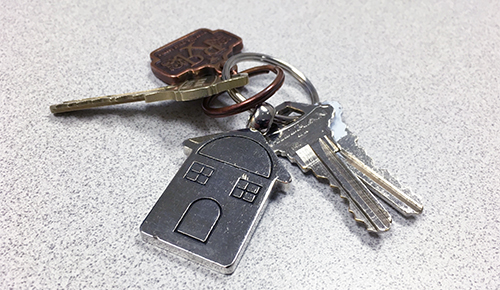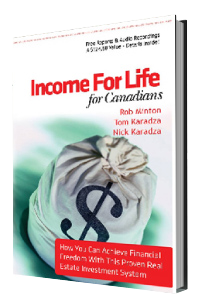Mortgage Rates Canada:
Three Ways To Make Your Mortgages Work Harder For You
Mortgage Rates Canada:
Investment Property Mortgage Techniques

Let's take a look at mortgage rates Canada: how can we make them work in our favour?
Before we begin, let’s make this clear: everything we’re about to share applies to investment property mortgages.
We wouldn’t recommend any of these for a mortgage on your personal home. Got it? Good.
Some background…
Our father taught us that debt was bad. Very bad.
We remember the day he celebrated with our mother about being the first on the street to have their mortgage paid off.
They had survived a mortgage rates Canada interest rate of 16.5% and had seen friends walk away from their homes. The mortgage rate Canada was facing was overwhelming. They managed to pay off the mortgage and owning their own home free and clear was part of the dream that Canada offered them.
So both Nick and myself heard how awful debt was and how you had to pay off all debt as fast as humanly possible.
And over the last few years, our parents wouldn’t be happy with us. We’re not being good stewards of debt repayment.
Here’s how we’ve been using mortgages rates Canada to increase cash flow...
Strategy Number One:
Don’t Pay It
This is getting a little more difficult to do as less and less mortgages allow it, but it’s worth looking into.
Some mortgages allow you to skip one payment during the term of the mortgage with no penalty to you whatsoever.
Now, in case it’s not obvious, this is a big deal.
If you’re mortgage rates Canada payment on an investment property is $1,300 per month that’s like adding $1,300 in cash flow to you by doing nothing more than making a couple phone calls.
Your mortgage broker or the bank you’re dealing with will tell you if your mortgage allows this. Or if you’re into reading fine print then pull out that mortgage rates Canada paper work and check it out for yourself.
It’s the easiest way to increase your cash flow that we know of.
Strategy Number Two:
Extend It
We used to aggressively pay off our investment property debt. On one property, we even had accelerated bi-weekly payments.
It took us a little while to understand that the interest on the debt was a tax deductible expense and that paying off debt on a property that cash flowed positively was not necessary.
We were using the strategies we use on our personal homes to pay off the mortgage on our investment properties. And, because debt on our personal homes is not tax deductible, the two situations are entirely different.
So for our next couple of properties we moved to long amortization periods and monthly payments.
And then something occurred to us.
After the term was up on some of these investment mortgages, almost all of the banks allow you to “reamortize” the mortgage back up to the maximum allowed amount.
So if you have a 30-year amortized mortgage of $230,000 at 4% interest and you’re making monthly payment of $1,210 … at the end of a five year term the mortgage has been paid down to $200,224.
Now, most banks will just “auto-renew” your mortgage if you don’t call them. They’ll give you the current interest rate and keep you on your existing amortization schedule so your payments will continue to be the same $1,210 per month.
Or if interest mortgage rates Canada have moved up, you’ll be paying even more than that.
At the very least, it’s wise to call or visit the bank where your mortgage resides and negotiate a lower interest rate by threatening to move your mortgage elsewhere. You’re a very profitable customer for them so they’ll typically lower the interest rate by a half or even full percentage point immediately.
So that’s tip number one.
Now, during the same phone conversation you ask them to extend the amortization upon the mortgage renewal back up to 30 years.
And let’s assume the mortgage rates Canada is the same, 4%.
Now your new monthly payment is $1,053. You’ve just created $157 in extra monthly cash flow for yourself.
Now, our father would scream at this because we’re not paying off debt. But we know that mortgage debt can be used as a tax deductible expense.
Our real challenge in dealing with mortgages on investment properties is not paying them off … it’s controlling the cost of the debt so that it doesn’t get out of hand.
So if interest mortgage rates Canada are beginning to spike up, we need to prepare for that with extra cash reserves.
It’s why we watch global monetary policy like a hawk. We want to know if the Bank of Canada will raise rates in a meaningful way before it actually happens.
Strategy Number Three:
Inflate It
We don’t like this strategy ourselves as much as #1 and #2 because it’s riskier, but we’ll explain it anyway because it’s being discussed more and more.
So for interest’s sake let’s get to it...
This is the strategy good old Uncle Sam in the U.S. is trying to use to get his debt load under control.
It’s also the strategy “investment advisors” will use to convince you to borrow more to invest with them.
This strategy has also been sent into us many times by Rock Star Inner Circle Members.
It’s really a different approach to Strategy Number
Two described above.
Here’s how it works:
1. You have a $300,000 investment property with a mortgage on it of $240,000, and you’re able to structure it so you’re making interest-only payments.
This is most common when large lines of secured credit are used to buy the property.
2. You assume inflation is running at 4% per year.
You can change this example by changing the rate of inflation to any number you’re comfortable with.
3. Instead of making monthly payments on that mortgage you take the money and use it to buy another investment property of $300,000, with a new $240,000 mortgage on it.
4. Now you let time pass and allow inflation at 4% to do your work for you.
Let’s examine the results….
If you had only stuck with one investment property and paid off its mortgage in twenty years, that property would be worth $500,000 assuming properties values in Canada appreciated at 5% a year.
You’re left with $500,000 in equity in one property.
Instead, because you’ve bought two properties and they’ve appreciated you now have $1,000,000 worth of property.
You’re ahead hundreds of thousands of dollars in equity and you’ve done nothing differently.
So why don’t we like this particular strategy as much as much as Strategy #1 and #2?
Because we find the people that use this often are spreading themselves too thin.
So although we don’t live by our father’s rules of paying off debt as quickly as possible we do live this rule … having enough emergency cash handy to survive rainy days.
And in real estate, rainy days are sudden moves in mortgage rates Canada and counting on appreciation to lighten your debt/mortgage burden.
We’ve found over the last twenty years that appreciation does always come but sometimes it gets lost. When it does get lost, appreciation can disappear for ten years at a time.
To us, Strategy # 3 only makes sense on a strong cash flowing property when you have enough cash reserves to survive some rainy days or even some rainy years. Clear enough?
And there you have it… Three different approaches to make your mortgages work harder for you!
Some Cool Free Stuff...
Step 1:
|
Grab a free digital copy of our real estate investing book, Income For Life For Canadians, right here. This book has been downloaded over 22,597 times and has helped hundreds of investors kick-start their investing with simple and straight forward strategies that you can implement right here in Canada. |
 |
|
You'll also receive our weekly [Your Life. Your Terms.] email newsletter with the latest investing updates and videos. |
Step 2:
|
Free Weekly Investing Videos & Articles: Get the latest updates and join the over 10,000 other Canadians enjoying the weekly [Your Life. Your Terms.] email newsletter. The email is sent out each Thursday. And as a little bonus we'll give a FREE digital copy of the book, Income For Life For Canadians, too! |
Your Life. Your Terms.
Step 3:
|
Free LIVE Investing Class: Do you live in the Greater Toronto or Golden Horseshoe Area? Come out to our next introductory "Investing in Nice Homes in Nice Areas" Real Estate Class. |
 |
|
It's 90-minutes and you'll learn a ton - promise!Thousands of investors have now joined us for this class and the feedback has always been amazing. |



